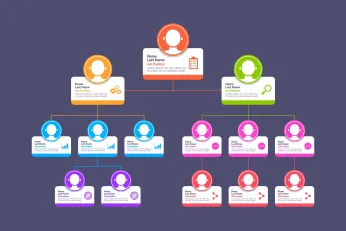Habilitación de ventas frente a operaciones de ventas: ¿Cuál es la diferencia?
Sales enablement equips teams with training and content, while sales operations focus on strategy and processes. Knowing the difference between sales enablement and sales operations improves efficiency and revenue.
En esta página
A successful sales strategy depends on more than just skilled sales reps—it requires the right structure, tools, and processes to support them. This is where sales enablement and sales operations come in. While both functions aim to improve sales performance, they serve different purposes. Without a clear understanding of the difference between sales enablement and sales operations, businesses may face inefficiencies that slow down revenue growth.
Sales enablement ensures sales teams have the proper training, content, and technology to engage prospects and close deals effectively. Sales operations, on the other hand, focus on the processes, data, and analytics that keep sales teams organized and efficient. While their responsibilities differ, both are critical in improving sales effectiveness and helping businesses scale.
In this guide, we’ll break down sales enablement vs sales operations, highlighting their unique roles, key differences, and how they work together to create a high-performing sales team.
¿Qué es la capacitación de ventas?
La capacitación de ventas es una estrategia global que integra formación, capacitación, contenido, tecnología, procesos y actividades para apoyar y capacitar a los representantes de ventas en el avance de las oportunidades de ventas a través de interacciones informadas con los clientes potenciales.
En esencia, la capacitación en ventas pretende mejorar la eficacia de los vendedores proporcionándoles el apoyo y la formación necesarios.
Another way to look at sales enablement is by aligning individuals, procedures, and objectives through relevant training, coaching, content, and communications.
The concept revolves around delivering appropriate actions to the right individuals at the right moment, directly correlating with improved sales performance. By aligning people, processes, and priorities with go-to-market metrics and revenue objectives, sales enablement can significantly enhance revenue generation, deal size, and win rates.
¿Por qué es importante la capacitación en ventas?
La capacitación de ventas es crucial por varias razones:
- Apoyar la productividad general de los vendedores: Al proporcionar a los representantes de ventas las herramientas, la formación y los recursos adecuados, la capacitación en ventas les ayuda a ser más eficientes y eficaces en sus funciones. Esto se traduce en una mayor productividad y mejores resultados de ventas.
- Reducing sales rep turnover: Sales enablement programs focusing on continuous learning and skill development can improve job satisfaction and engagement among sales reps. This, in turn, can reduce turnover rates and ensure a more stable and motivated sales team.
- Proporcionar una base de conocimientos accesible: La capacitación de ventas crea y mantiene un repositorio central de conocimientos, mejores prácticas y recursos al que los representantes de ventas pueden acceder fácilmente. Esto les ayuda a mantenerse informados, responder a las preguntas de los clientes con mayor eficacia y cerrar acuerdos más rápidamente.
- Mantener informados a los clientes potenciales: La capacitación en ventas garantiza que los representantes comerciales tengan acceso a información actualizada y precisa sobre productos, servicios y tendencias del sector. Esto les permite educar a los clientes potenciales con eficacia, abordar sus preocupaciones y generar confianza, lo que en última instancia conduce a compromisos de ventas más exitosos.
- Refining sales enablement through measurement: By measuring sales effectiveness over time, companies can identify areas for improvement in their sales enablement strategies. This data-driven approach allows organizations to refine their sales enablement efforts, optimize resources, and drive better results.
Responsabilidades de un especialista en capacitación de ventas
A sales enablement specialist plays a crucial role in equipping sales teams with the tools, resources, and strategies they need to close deals effectively. From training and content creation to streamlining processes, their work directly impacts sales performance. Here are the core responsibilities that define this role.
1. Facilitating communication between sales, marketing, product teams, and senior management
A sales enablement specialist is a crucial link between the sales, marketing, product teams, and senior management. They facilitate communication, collaboration, and alignment of strategies to ensure all departments work towards common goals.
2. Developing content tailored for the sales team
They are tasked with creating customized content specifically for the sales team. This content is designed to address the unique needs and challenges faced by sales professionals, helping them engage with customers more effectively and drive sales.
3. Educating and guiding sales representatives on utilizing sales enablement materials:
A sales enablement specialist is responsible for training and mentoring sales representatives on effectively using sales enablement content. This includes guiding how to incorporate the content into their sales processes and strategies and helping them understand the value and benefits of the content for their sales efforts.
4. Structuring and enhancing sales enablement content
They are also tasked with organizing and optimizing it. This involves categorizing and structuring the content in a way that is easy for sales reps to access and use, as well as ensuring that the content is up-to-date and aligned with the needs of the sales team and the target market.
5. Performing market research and collecting feedback
Sales enablement specialist is involved in conducting market research and gathering feedback. This includes staying informed about market trends, competitor activities, and customer preferences, as well as collecting feedback from sales reps and other stakeholders to improve the effectiveness of sales enablement content and strategies continuously.
¿Qué herramientas se necesitan para la capacitación de ventas?
Here are the essential tools that streamline sales enablement, helping teams access the right resources, automate processes, and close deals faster. These tools improve collaboration, enhance productivity, and ensure sales reps have everything they need to engage prospects effectively.
1. LevelEleven
LevelEleven is a sales management tool that tracks activities, analyzes sales strategies, and integrates with Salesforce. It allows you to create custom contests, provides dashboards for sales leaders, and features Channel 11 TV for real-time updates on sales activities.
2. Membrain
Membrain enhances sales effectiveness by enabling teams, executing processes, coaching, and optimizing strategies. It offers complete sales enablement, assisting with processes, training, content management, and automation. The platform integrates with Salesforce, Hubspot, and Zendesk, and provides a comprehensive overview of sales projects with the Story Stream feature.
3. Whatfix
Whatfix offers in-app guidance for training sales reps, simplifying learning for complex applications like Salesforce. It reduces the need for repeated training content creation and helps retain knowledge with quick, interruption-free guides. The platform also provides real-time walkthroughs and a Self-Help widget to lower support costs.
4. Mindtickle
Mindtickle is a platform that helps companies increase revenue by improving sales knowledge and behaviors. It helps you create programs that reinforce knowledge, analyze sales meetings, and enhance the sales process.
With Mindtickle, you can identify successful sales behaviors that lead to positive outcomes. It provides personalized training and practice for each salesperson to adopt these behaviors.
5. Sísmico
Seismic is a platform that centralizes sales resources and content, offering global version control and approval tools. It provides personalized content for each buyer interaction, enhancing sales productivity.
Seismic curates news, competitive information, and product updates to empower sales teams. It also offers predictive content recommendations for the selling process.
¿Qué son las operaciones de venta?
Las operaciones de ventas abarcan diversas tareas, como la gestión de clientes potenciales, el desarrollo de estrategias de ventas y la alineación de territorios. También incluye la mejora de los procesos de ventas, la creación de planes de compensación, la implantación de la automatización de ventas, la formación y el análisis de datos.
El objetivo principal de un equipo de operaciones de ventas es la planificación de ventas y operaciones (S&OP). Esto implica la coordinación entre departamentos y la actualización de las previsiones de ventas y presupuestos para garantizar que todos los aspectos de la empresa funcionan a la perfección.
El objetivo de las operaciones de ventas es agilizar el proceso de ventas, permitiendo a los miembros del equipo de ventas centrarse en sus tareas principales sin distracciones. Los equipos de operaciones de ventas deben gestionar la planificación sistémica, utilizar eficazmente las herramientas tecnológicas y ofrecer formación a toda la empresa para lograr este objetivo.
Why is sales operations important?
Las operaciones de venta son cruciales por varias razones:
- Colaboración: Demuestra beneficios cuantificables al reunir a diferentes equipos para lograr objetivos comunes. Cuando los equipos colaboran eficazmente, pueden lograr mejores resultados y mejorar el rendimiento general.
- S&OP clarity: Sales and Operations Planning (S&OP) creates a clear outline of how different departments can work together. This alignment ensures that everyone is on the same page, reducing confusion and improving efficiency.
- Greater organization: Sales operations lead to greater organization within the sales team and across departments. This organization leads to clarity in roles, responsibilities, and processes, resulting in smoother operations and better outcomes.
Sales operations roles and responsibilities
Sales operations teams handle the processes, tools, and strategies that keep a sales team running efficiently. Their role goes beyond administrative support, focusing on data-driven decisions, process improvements, and sales enablement. Here’s a breakdown of their key responsibilities.
1. Sales data management
En un puesto de operaciones de ventas, una de las principales responsabilidades es gestionar los datos de ventas. Esto implica garantizar que los datos sean precisos y estén actualizados, así como mantener y actualizar las bases de datos de ventas. Además, generar informes periódicos para el equipo de ventas y la dirección y analizar los datos de ventas para identificar tendencias y perspectivas son aspectos cruciales de esta función.
2. Previsión de ventas
Los profesionales de operaciones de ventas colaboran con los equipos de ventas y marketing para desarrollar previsiones de ventas precisas. Esto incluye analizar los datos históricos de ventas y las tendencias del mercado para predecir las ventas futuras, y ajustar las previsiones en función de los cambios en las condiciones del mercado o las prioridades empresariales. A continuación, las previsiones de ventas se facilitan a la alta dirección para ayudar en la toma de decisiones.
3. Sales representative support
Sales operations professionals provide support to sales representatives. This includes training and onboarding new sales representatives, assisting them with questions related to products, processes, or tools, and collaborating with the marketing team to develop sales collateral and presentations.
Ultimately, the goal is to support sales representatives in achieving their sales targets and driving business growth.
4. Performance management
Sales operations play a crucial role in the performance management of a sales team. This includes collaborating with senior management to establish performance targets and then monitoring individual and team performance closely.
By identifying areas for improvement, sales operations can implement strategies to enhance sales performance, providing ongoing feedback and coaching to help sales representatives achieve their targets effectively.
5. Sales team organization
In terms of sales team organization, sales operations is responsible for designing and implementing sales territories and quotas. They allocate resources strategically to maximize sales productivity and organize sales meetings and training sessions to keep the team informed and motivated.
Collaboration with other departments, such as marketing and product teams, ensures alignment with sales objectives.
6. Sales incentives management
Sales incentives are rewards given to salespeople for achieving specific goals or targets. Compass is a platform used to manage sales incentives and commissions. It could track sales performance, calculate incentives based on predefined rules, and provide visibility to both the sales team and management.
Sales incentives are crucial for motivating salespeople to achieve their targets and drive performance.
7. Sales motivation
Sales motivation refers to the techniques or strategies used to keep the sales team engaged, enthusiastic, and focused on their goals. One of the best ways to motivate is by offering Xoxoday gift cards and experiences as a way to motivate the sales team.
These rewards provide tangible benefits that go beyond monetary compensation, such as memorable experiences or the ability to choose a reward that suits individual preferences. This approach helps boost morale, maintain high levels of motivation, and improve overall sales performance.
What tools are needed for sales operations?
Here are the essential tools that keep sales operations running smoothly, from tracking performance to managing pipelines. The right mix of technology helps teams stay organized, close deals faster, and maintain clear communication across the sales process.
1. Clari
Clari is a tool for sales teams that uses data science to help them sell better and faster. It can predict sales patterns, improve how teams communicate, and provide useful insights to close deals quickly. Key features include predicting sales trends, managing forecasts, sending tips directly to reps' phones, and coaching with data-driven strategies.
2. Nube de ventas Salesforce
Sales Cloud, a part of Salesforce, provides a live overview of your team's sales predictions. It allows for real-time adjustments and gives visibility to managers at all levels.Salesforce claims that Sales Cloud offers several advantages, such as providing an accurate view of the entire sales pipeline, tracking individual sales performance, and managing forecasts for complex sales teams.
3. Compass
CompassCompass, una plataforma de automatización de comisiones de ventas, agiliza las operaciones de ventas automatizando los programas de incentivos y los cálculos de comisiones, reduciendo errores y ahorrando tiempo. Ofrece análisis claros sobre el rendimiento de las ventas, es escalable y se integra perfectamente con los sistemas CRM y ERP. Esto mejora la eficacia operativa e impulsa el crecimiento de los ingresos, lo que hace que Compass sea esencial para una gestión eficaz de las ventas.
4. Mapas del tejón
Badger Maps is software for field sales reps, offering route mapping and territory design. It allows reps to view customer information on a map, identify high-potential areas, and automate territory mapping and route optimization. It integrates with any CRM and caters to businesses of all sizes.
Key differences between sales enablement and sales operations
Understanding the key differences between sales enablement and operations helps businesses structure their sales teams effectively. While sales enablement focuses on training, content, and tools, sales operations handle strategy, processes, and data management. Aligning both functions ensures a more efficient and results-driven sales approach.
Both sales enablement and sales operations are essential for a high-performing sales team. While one focuses on empowering sales reps, the other ensures they have the right infrastructure to succeed.
How sales enablement and sales operations work together
La capacitación de ventas y las operaciones de ventas colaboran estrechamente para apoyar al equipo de ventas e impulsar los ingresos. Mientras que la capacitación de ventas se centra en preparar y educar a los representantes de ventas, las operaciones de ventas garantizan la correcta ejecución del proceso de ventas. Ambos equipos trabajan en estrecha colaboración con la dirección para ayudar a los representantes a lo largo del ciclo de ventas, comprendiendo las perspectivas ideales, el recorrido del cliente y el cierre de acuerdos para facilitar las ventas de forma eficaz.
Es importante señalar que, en lugar de competir, la capacitación de ventas y las operaciones se complementan mutuamente. La capacitación de ventas y las operaciones colaboran en los planes de gestión del cambio, incluida la formación, la medición de la adopción y el suministro de recursos. Coordinan actividades como las horas de oficina y las sesiones de preguntas y respuestas. Esta colaboración garantiza que ambos equipos presten un apoyo eficaz al personal de ventas sin duplicar esfuerzos.
La comunicación eficaz es crucial. Las operaciones de ventas deben compartir la estrategia de ventas y las métricas de éxito, mientras que la capacitación debe ser transparente sobre las iniciativas de marketing y el contenido de la formación. Esta comunicación continua ayuda a ambos equipos a alinear sus esfuerzos y contribuir al éxito de la estrategia de ventas.
En resumen, la capacitación de ventas y las operaciones de ventas, aunque separadas, son más eficaces cuando están alineadas. Las operaciones optimizan las herramientas y la tecnología, mientras que la capacitación mejora la eficacia de los representantes de ventas en las interacciones con los compradores. Juntos, pueden mejorar significativamente la productividad y la eficiencia del proceso de ventas.
Case Study 1: Enhancing team dynamics with innovative training solutions
This case study examines the successful implementation of Bigtincan’s onboarding and training solutions by one of the oldest and loudest teams in the NBA. The initiative aimed to streamline the training process, enhance knowledge sharing among team members, and optimize coaching strategies to maintain a competitive edge.
Desafíos
El equipo se enfrentó a varios retos que afectaron a su eficacia y rendimiento operativos:
- Formación incoherente: Los miembros nuevos y existentes del equipo tuvieron experiencias de formación variadas, lo que dio lugar a incoherencias en los conocimientos y aptitudes de todo el equipo.
- Comunicación ineficaz: Los deficientes canales de comunicación obstaculizaron el intercambio eficaz de conocimientos y la colaboración entre los jugadores y el cuerpo técnico.
- Procesos de incorporación obsoletos: El proceso de incorporación tradicional requería mucho tiempo y no lograba implicar a los miembros del equipo de forma eficaz, lo que repercutía en su experiencia inicial y en su rendimiento a largo plazo.
Soluciones
Para hacer frente a estos retos, el equipo colaboró con Bigtincan para implantar una solución integral:
- Plataforma de formación unificada: Bigtincan proporcionó una plataforma centralizada que estandarizó los materiales y métodos de formación, garantizando la coherencia en todos los niveles del equipo.
- Herramientas de comunicación mejoradas: La solución incluía herramientas de comunicación avanzadas que facilitaban una mejor interacción entre jugadores y entrenadores, mejorando la formulación y ejecución de la estrategia global.
- Experiencia de incorporación interactiva: El nuevo proceso de incorporación se diseñó para ser atractivo e informativo, integrando contenidos multimedia e interactivos para mejorar el aprendizaje y la retención.
Resultados
La aplicación de las soluciones de Bigtincan dio lugar a mejoras significativas:
- Improved Performance Consistency: With standardized training, the team members consistently performed more, reducing the gap between new and existing players.
- Mayor compromiso y colaboración: Las herramientas de comunicación mejoradas fomentaron un entorno de mayor colaboración, en el que los conocimientos y las estrategias se compartieron libremente, dando lugar a planteamientos innovadores y mejores planes de juego.
- Reducción del tiempo de incorporación: el renovado proceso de incorporación redujo el tiempo necesario para poner al día a los nuevos miembros, lo que les permitió contribuir antes al éxito del equipo.
Case Study 2: Transforming sales operations with Salesforce CRM
This case study examines the transformation of a company's sales operations through the implementation of Salesforce CRM. The company faced numerous challenges in managing its sales processes, which affected its overall performance and customer relations.
Desafíos
La empresa se encontró con varios problemas importantes antes de implementar Salesforce CRM:
- Fragmented customer data: Information about customers was scattered across different platforms, leading to inefficient sales processes and poor customer service.
- Inefficient lead management: Sales leads were not being tracked systematically, resulting in missed opportunities and low conversion rates.
- Lack of sales analytics: There was an absence of real-time analytics, making it difficult to measure sales performance and make data-driven decisions.
Soluciones
Para abordar estos retos, la empresa implementó Salesforce CRM con las siguientes estrategias:
- Centralized customer data: Salesforce CRM centralized all customer information into a single platform, improving access to data and enhancing customer service.
- Automated lead management: The CRM system automated the tracking and nurturing of leads, which improved lead conversion rates and sales efficiency.
- Advanced sales analytics: The implementation of advanced analytics tools within Salesforce allowed for real-time performance tracking and better strategic planning.
Resultados
La adopción de Salesforce CRM transformó las operaciones de ventas de la empresa con resultados notables:
- Enhanced customer relations: Centralized data improved the quality of customer interactions, leading to higher customer satisfaction and retention rates.
- Increased sales efficiency: Automated lead management resulted in a higher conversion rate and more effective sales processes.
- Data-driven decision making: Access to real-time analytics empowered the sales team to make informed decisions, significantly enhancing sales strategies and outcomes.
Conclusión
While sales enablement and sales operations are distinct functions within a sales organization, they are both essential for driving success. Sales enablement empowers sales teams with the right tools, training, and resources to engage effectively with customers.
Por otro lado, las operaciones de venta agilizan el proceso de venta, optimizan las herramientas de venta y garantizan la eficacia de las actividades de venta.
Organizations can better leverage their strengths to maximize sales performance by understanding each function's unique roles and responsibilities. A harmonious collaboration between sales enablement and operations is key to achieving sales excellence and driving business growth.














